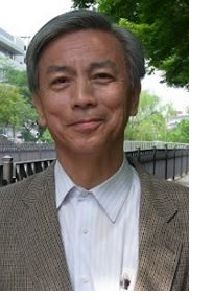




FUMIO ARISAKA


fumio.arisaka@gmail.com





Gene Products that drive the formation of the baseplate of bacteriophage T4
Abstract
The baseplate is a key structure of the successful infection, which is located at the distal end of the tail. It consists of a hub and six wedges surrounding the former (1). In the present study, the wedge which was known to assemble in a strictly sequential manner was formed by mixing E. coli cells in which six gene products were separately expressed, mixed and then lysed. All the assembly intermediates of the wedge were formed and isolated as expected. However, when gp53 which is the penultimate gene product to be associated was added to the wedge intermediate, six wedge intermediates spontaneously associated to form a “baseplate-like structure” which is similar to the contracted form of the baseplate (2). The structure of the in vitro-formed baseplate-like structure with the molecular weight of 3.3 MDa were elucidated by both X-ray crystallography (3) and 3D-image reconstruction from electron micrographs. Interestingly, the resolution of the latter, 3.5 A, was higher than that of the former, 4.2 A (Yap et al., PVA meeting, June 7 - 12, 2015, Les Diablerets, Switzerland). The elucidated structure of the baseplate not only revealed the hitherto unknown structures of some gene products including gp7, but also elucidated why the association of gp53 spontaneously form the hexamer of the wedges (Yap et al., in preparation).
References
[1] Leiman P, Arisaka F et al. (2010) Morphogenesis of the T4 tail and tail fibers. Virol. J. 7:355-382.
[2] Yap ML, Mio K, Leiman PG, Kanamaru S, Arisaka F (2010) The baseplate
wedges of bacteriophage T4 spontaneously assemble into hubless baseplate-
like structure in vitro. J Mol Biol 2010, 395:349-360.
[3] Yap ML et al. (2014) Structure of the 3.3MDa, in vitro assembled, hubless
bacteriophage T4 baseplate. J Struct Biol. 187, 95-102.
2014-present: Professor Emeritus of Tokyo Institute of Technology; Research Fellow, School of Bioresource Science, Nihon University
2010-2014: Professor, Grad Sch of Biosci. and Biotech., Tokyo Institute of Technology
1990-2010: Associate Professor, Dept. of Life Science, Tokyo Institute of Technology
1980-1990: Assistant Professor, Faculty of Pharmaceutical Sci., Hokkaido University
1977: PhD, School of Science, Oregon State University, U.S.A.
Research Fields and Interests:
Structure and assembly of protein supramolecular structure. We have been focusing on the structure, assembly and conformational change of the contractile tail of bacteriophage T4. For the study of solution interactions of the phage proteins, we are utilizing size exclusion chromatography, analytical ultracentrifugation and light scattering. Through these studies, we hope to elucidate the mechanism of structure formation of the tail in the infected cells and structure change of the baseplate upon infection.
Selected Publications:
Sanghamitra NJ, Inaba H, Arisaka F, Ohtan Wang D, Kanamaru S, Kitagawa S, Ueno T.
(2014) Plasma membrane translocation of a protein needle based on a triple-
stranded β-helix motif. Mol Biosyst. 10, 2677-83.
Uchida K, Leiman PG, Arisaka F, Kanamaru S. (2014) Structure and properties of the C- terminal β-helical domain of VgrG protein from Escherichia coli O157. J Biochem. 155, 173-82.
Iwura T, Fukuda J, Yamazaki K, Kanamaru S, Arisaka F. (2014) Intermolecular interactions and conformation of antibody dimers present in IgG1 biopharmaceuticals. J Biochem. 155, 63-71.
Fokine A, Zhang Z, Kanamaru S, Bowman VD, Aksyuk AA, Arisaka F, Rao VB, Rossmann MG. (2013) The molecular architecture of the bacteriophage t4 neck. J Mol Biol. 425, 1731-44.
Fumio Arisaka, Yukifumi Nagai, Masako Nagai (2011) Dimer-tetramer association
equilibraia of human adult hemoglobin and its Mutants as observed by analytical
ultracentrifugation. Methods 54, 175-80.